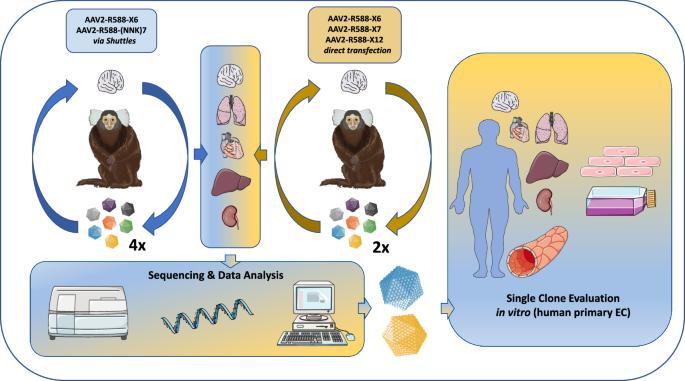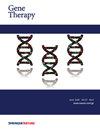Identification of AAV variants with improved transduction of human vascular endothelial cells by screening AAV capsid libraries in non-human primates
IF 4.5
3区 医学
Q1 BIOCHEMISTRY & MOLECULAR BIOLOGY
引用次数: 0
Abstract
The development of targeted vector systems for gene therapy has made impressive progress during the last decade. Promising vector candidates were identified by screening large pools of adeno-associated virus (AAV) mutants in small animal models. However, it became apparent that targeted AAV mutants isolated from rodents may not function in humans as the tropism of individual AAV mutants can differ between species. To identify novel vascular-targeted AAV capsid mutants suitable for treating human patients, we generated a set of AAV2 display peptide libraries and screened them in the common marmoset, a non-human primate. To evaluate the impact of different AAV library production methods, progress of the screening process was monitored by next generation sequencing. Particle distribution and enrichment was compared between different AAV libraries and selection rounds. We observed enrichment of AAV variants in the brain and other well-perfused organs (lung, heart, kidney) potentially mediated by high capsid affinity for the vascular endothelium in general. In vitro experiments on primary human microvascular endothelial cells isolated from a set of different organs (brain, heart, lung, liver, kidney and spleen) confirmed superior transduction of a selected AAV variant displaying the “DWP” amino acid sequence motif compared to natural AAV serotypes 1–9.

通过筛选非人灵长类动物AAV衣壳文库,鉴定具有改善人血管内皮细胞转导的AAV变体。
基因治疗的靶向载体系统的发展在过去十年中取得了令人印象深刻的进展。通过在小动物模型中筛选大量腺相关病毒(AAV)突变体,确定了有希望的候选载体。然而,很明显,从啮齿动物中分离的靶向AAV突变体可能在人类中不起作用,因为单个AAV突变体的倾向性可能因物种而异。为了鉴定适合治疗人类患者的新型血管靶向AAV衣壳突变体,我们生成了一组AAV2展示肽文库,并在普通狨猴(一种非人灵长类动物)中进行了筛选。为了评估不同AAV文库制作方法的影响,通过下一代测序监测筛选过程的进展。比较了不同AAV文库和筛选轮之间的颗粒分布和富集情况。我们观察到AAV变异在大脑和其他灌注良好的器官(肺、心脏、肾脏)中富集,这可能是由对血管内皮的高衣壳亲和力介导的。在从不同器官(脑、心、肺、肝、肾和脾)分离的原代人微血管内皮细胞上进行的体外实验证实,与天然AAV血清型1-9相比,选择的显示“DWP”氨基酸序列基序的AAV变体具有优越的转导能力。
本文章由计算机程序翻译,如有差异,请以英文原文为准。
求助全文
约1分钟内获得全文
求助全文
来源期刊

Gene Therapy
医学-生化与分子生物学
CiteScore
9.70
自引率
2.00%
发文量
67
审稿时长
4-8 weeks
期刊介绍:
Gene Therapy covers both the research and clinical applications of novel therapeutic techniques based on a genetic component. Over the last few decades, significant advances in technologies ranging from identifying novel genetic targets that cause disease through to clinical studies, which show therapeutic benefit, have elevated this multidisciplinary field to the forefront of modern medicine.
 求助内容:
求助内容: 应助结果提醒方式:
应助结果提醒方式:


